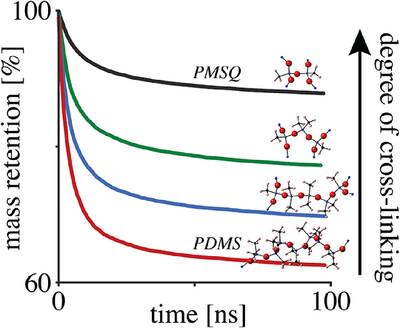交联问题:聚甲基硅氧烷热降解的原子模拟
IF 2.9
4区 工程技术
Q1 MULTIDISCIPLINARY SCIENCES
引用次数: 0
摘要
利用Si─C─O─H的先进机器学习原子间势(MLIP),研究了从线性聚二甲基硅氧烷(PDMS)到高度网络化聚甲基硅氧烷(PMSQ)的聚硅氧烷的热击穿。反应模拟表明,增加交联密度可以提高热解后的热稳定性和陶瓷收率。形成硅氧烷低聚物的多种途径是未发现的,这些途径取决于聚合物中未支化单元的数量。通过模拟气态物质的释放,再现了实验中观察到的质量保持曲线:PMSQ表现出最高的质量保持,而PDMS则倾向于大量的质量损失。非等温模拟产生了热重研究,并表明更高的热稳定性和质量损失率峰值与交联程度一致。此外,这些模拟能够对TGA数据进行动力学分析,得出PDMS降解的活化能,与文献值一致。最后,研究表明,嵌入在PMSQ矩阵中的PDMS结构域作为牺牲模板,雕刻出纳米级的空隙,从而在最终的SiCO陶瓷中产生定制的孔隙度。总的来说,原子模拟提供了对反应机制的见解,验证了实验趋势,并为调整预陶瓷聚合物向定制陶瓷产量和微观结构提供了预测指导。本文章由计算机程序翻译,如有差异,请以英文原文为准。

Cross-Linking Matters: Atomistic Simulations of the Thermal Degradation of Polymethylsiloxanes
Utilizing an advanced machine-learning interatomic potential (MLIP) for Si─C─O─H, the thermal breakdown of polysiloxanes covering polymers from linear polydimethylsiloxane (PDMS) to highly networked polymethylsilsesquioxane (PMSQ), is investigated. The reactive simulations reveal that increasing cross-linking density enhances both thermal stability and ceramic yield after pyrolysis. Multiple pathways for forming siloxane oligomers are uncovered–pathways that depend on the number of unbranched units in the polymer. By simulating the release of gaseous species, the mass-retention profiles observed in experiments are reproduced: PMSQ exhibits the highest mass retention, while PDMS is prone to substantial mass loss. Non-isothermal simulations produce thermogravimetric studies and show that higher thermal stability and the peak of mass loss rate align with the degree of cross-linking. Moreover, these simulations enable a kinetic analysis of TGA data, yielding an activation energy for PDMS degradation that is consistent with literature values. Finally, it is shown that PDMS domains embedded within PMSQ matrices act as sacrificial templates, carving out nanoscale voids that give rise to tailored porosity in the final SiCO ceramics. Overall, the atomistic simulations provide insights into reaction mechanisms and validate experimental trends and offer predictive guidance for tuning preceramic polymers toward tailored ceramic yields and microstructures.
求助全文
通过发布文献求助,成功后即可免费获取论文全文。
去求助
来源期刊

Advanced Theory and Simulations
Multidisciplinary-Multidisciplinary
CiteScore
5.50
自引率
3.00%
发文量
221
期刊介绍:
Advanced Theory and Simulations is an interdisciplinary, international, English-language journal that publishes high-quality scientific results focusing on the development and application of theoretical methods, modeling and simulation approaches in all natural science and medicine areas, including:
materials, chemistry, condensed matter physics
engineering, energy
life science, biology, medicine
atmospheric/environmental science, climate science
planetary science, astronomy, cosmology
method development, numerical methods, statistics
 求助内容:
求助内容: 应助结果提醒方式:
应助结果提醒方式:


